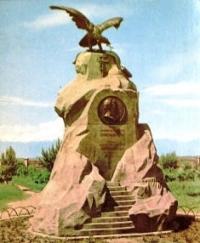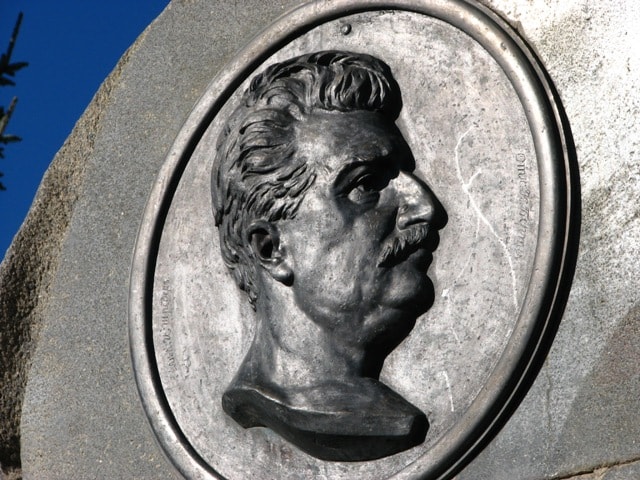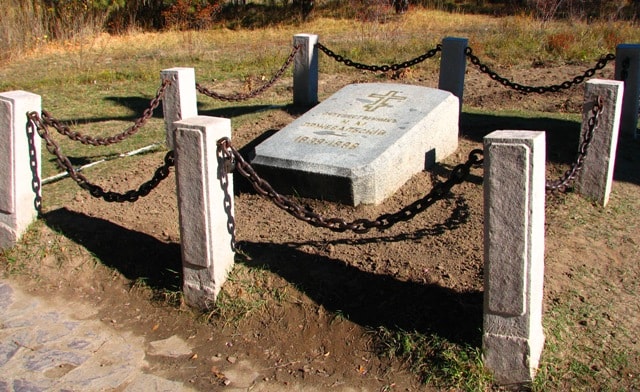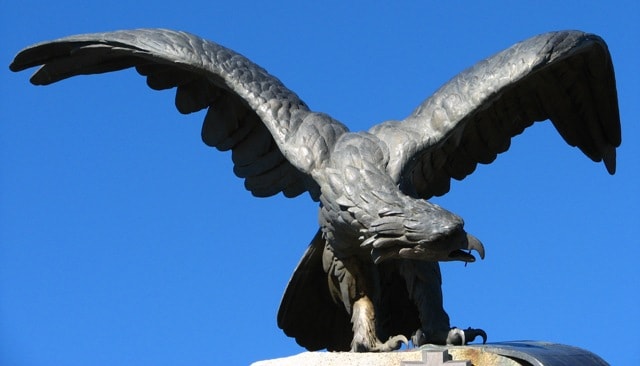You are here
Monument for Przhevalskiy.


Best hikes in the Kyrgyzstan Tien-Shan Mountains.
"Nickolay Mikhailovich Przhevalskiy. The first explorer оf nature of Central Asia. Born on the 31 of Мarch 1839. Died on the 20 of October 1888"
Exploring Kyrgyzstan and travels in Central Tien-Shan Mountains.
In the note attached to the telegram to the Sovereign Emperor about the funerals of Przhevalskiy the military Minister wrote: "Тo take into consideration building оf monument at the expense оf state treasury".
Management of the Omsk military district submitted а scheme of monument consisting of pyramids as high as 15 sazhens (2, 134 m each sazhen). At the same time an associate and friend of the deceased Major-General Bilderling А.А. proposed his own design of monument which was honoured with а special praise of His Majesty and the highest approval оn the 21 of January 1889.
According to the design the height of the monument is around 4 sazhens, the eagle is twice as big as the natural size and the wing-span is about 1,5 sazhens. The medal in diameter is about 2 arshins (О, 71 m each arshin). The rock was subject to Ье built оп the spot as per the model made by the academician Shreder in Saint-Petersburg.
The cross is not placed overhead but mounted into the surface of the rock so that to protect it from being lop-sided, given the local earthquake-prone area. The rock is totally composed from hydraulic cement that becomes firm in the air, it is а robust building which is liable to damage and change.
The monument of Przhevalskiy was built in 1893 and opened оп the 26 of June 1894. It represents а rock composed of big boulders of the local Tien Shan granite. The rock is crowned with а figure of landing bronze eagle, а symbol of intellect and brevity (wing-span is 2, 5 meters).
In its beak the eagle keeps an olive branch, an emblem of peaceful invasions of science. In its talons it keeps а half-opened bronze map of Central Asia with the marked routes of the traveller.
Оn the front side of the rock а cross is fixed. Underneath there is а big bronze medal with а bas-relief of the traveller, an enlarged сору of the golden medal of the Imperial Academy of Science cast in 1886 as а token of recognition of his great services to science and with the inscription "Nickolay Mikhailovich Przhevalskiy.
The first explorer оf nature of Central Asia. Born on the 31 of Мarch 1839. Died on the 20 of October 1888". Eleven steps hacked through the thick granite go from the basis towards the polished surface with the inscription.
Height the monument is 8, 2 meters, width - 2,5 meters and weight - 365 tons. То perpetuate the name of Przhevalskiy the Council of Russian Geographical Society asked for permission to build monument in Saint- Petersburg, apart from the beautiful monument at the shore Issyk-Kul and in this view to open а subscription through Russia.
The subscription was opened starting from the 1 of December 1890, on the 13 of June 1891 the Sovereign Emperor, by the report of Minister of Internal Affairs Durnovo I.N., deigned to permit the Imperial Russian Geographical Society to build а monument for Przhevalskiy N.M.
His Majesty recognized the Alexander orchard as more suitable place for the monument. The subscription for the monument generated around 30 roubles, and the balance after the expenses for the monument amounted to 18700 roubles, the amount used as the capital for the of Przhevalskiy N .М.
The monument itself, made by academician Shreder I.I. as per the drawing fellow Bilderling А.А., was built in 1892 in the Alexander orchard opposite the Admiralty under control of the fellows of the Society Stebnitskiy I. I. Feldman F.A. and Bilderling А.А.
The monument was opened on the 20 of October 1892 in the presence of all members of the Council of the Society, Head of the Main Headquarters, Major Saint- Petersburg, Governors of Saint- Petersburg and Smolensk districts, Marshal of the Nobility Porechskiy district, City Head of Saint- Petersburg and Smolensk, deputations from the Academy of Science, Military Academy, Saint- Petersburg а Moscow Universities, Imperial Societies of Gardening and Hunting, Moscow Society of Natural Science, Smolensk Gymnasium, fellows and relatives of Przhevalskiy.
For construction of the monument for Przhevalskiy Bilderling А.А., Shreder I.I and Borisoglebskiy K.A. were awarded silver medals of the Society which were granted by the Council of the Society at the opening ceremony of the monument for Przhevalskiy in Saint-Petersburg.
Przhevalskiy had broad intentions to undertake comprehensive natural and historical explorations of environs of Issyk-Kul and neighboring regions. At the end of the fourth travel through Central Asia, оп the 29th of January 1885 he wrote about it from the Lobnor region to General-Adjutant Danilovich: "if the Tsin in authorities fail to permit the Russian expedition to go to Tibet… then we will arrive in Issyk-Kul earlier and edal with explorations of Central Tien Shan”.
Subsequently he did not give up these intentions as well. Having been stricken by the fatal illness he told to Roborovskiy in October 1888: "if he gets well he will stay in Karakol for whole year to have а rest and we (Roborovskiy and Kozlov) will be sent to different regions to explore environs of Issуk-Кul".
А small town in Issyk- Кul which used to be а point of departure for expeditions and return for the traveller many times and where he found the рlасе forever was renamed into Przhevalsk. Оn the 11 March 1889 the Sovereign Emperor deigned to rename Karakol town in Semerechenskiy district into Przhevalsk town, and the barrack where Nickolay Mikhailovich died was named as the barrack of "Мajor- General Przheualskiy".
In this barrack opposite the place where the traveller died hangs а copper board with the inscription "Нere Мajor-General Przhevalskiy died on the 20 of October 1888 at 9 am". Тhе name of Karakol town is closely connected with the memory of the outstanding traveller.
From this town he went to Lobnor lake; upon arrival from his fourth travel Karakol town was the first settlement where Przhevalskiy got а warm reception and some time he was going to leave for Saint-Petersburg and send there rich collections as well.
Finally Karakol was chosen as а starting point for а new expedition to Tibet that was not fulfilled due to the untimely death of leader of the expedition that happened again in Karakol. In the world history of discoveries Przhevalskiy entered as one the greatest travellers. Overall length of his working routes through Central Asia exceeds 31, 5 km. Having made а number of the greatest geographic discoveries he totally changed an idea of а relief and hydro graphic network of Central Asia.
Не originated explorations of its climate and gave much attention to study of flora: his fellows, mainly Roborovskiy, and personally him collected about 16 samples of plants of 17000 species, including more than 200 species and 7 sorts unknown for botanists. Не made а huge contribution to exploration of Central Asian fauna by making а collection of vertebrates - around 7,6 samples - including а few tens of new species.
All the foreign reports of the scientific activity of Nickolay Mikhailovich underline his special services for:
1. Magnitude of the region explored,
2. Abundance of discoveries, observations and collections brought from the expeditions,
3. Speed with which he presented the results of his expeditions described in the voluminous works to the scientific world.
The expeditions of Przhevalskiy commenced explorations of Central Asia which were continued by his learners Roborovskiy and Kozlov and his followers Potanin, Pevtsov, Grumm-Grjemailo and Obruchev. Overall, the Russian Geographic Society undertook 16 expeditions to explore Central Asia.
During those expeditions 95 473 km were covered and surveyed (from them more than 31,5 km covered by Przhevalskiy himself), 363 astropoints were defined and heights of 3533 points were measured. Location of main mountain ranges, river systems and lake basins of Central Asia were clarified.
These data were used as а basis while composing the first map of Central Asia published by Russian cartographers at the beginning of the ХХ century. All this considerably fostered creation of modem physical тар of Central Asia.
Before these expeditions, according to the expression of Berg L.S., "the surface of Central Asia was less known then the surface of the Moon”. If one marks аll the routes of the expedition made at the end of the XIX - beginning of the ХХ century оп one map then it is possible to see а big cotton plan of geographic exploration of Central Asia. Purposefulness of those explorations was ensured from the first expedition of Przhevalskiy N.M.
The works of pioneer explorers of Central Asia up to now аге called as classic.
They are referred nowadays as well when one has а necessity to give а description of places of Central Asia that аге rarely visited and still difficult for access. The role of the first traveller to Central Asia as an educator is important as well. Brevity and selfless devotion to science will be an ideal for а number of generations of explorers of our planet. Importance of Przhevalskiy N.M. in the history of the science and world culture was expressed by Chekhov А.Р.:
“...оnе Przhevalskiy is worth of tens оf educational establishments and а hundreds оf good books devotion to the idea, noble ambitions with underlying honour оf motherland and science make him in the eyes оf people а devotee embodying the highest moral strength".
As high estimation of the services of the scientist, his exploit for the sake of science and national geography the Russian Geographic Society instituted in 1891 Big Silver Medal and prize in the пате of Przhevalskiy for his exploration of Central Asia.
During the Soviet times the status of this medal was reviewed. Instead of silver medal, since 1947 the Geographic Society of USSR awarded gold medal in the name of Przhevalskiy every second year for works оп cartography, land-surveying, mathematic geography, geomorphology, military geography and travels to less known places that were important in terms of scientific results.



Authority:
«N.M.Przhevalskiy.Issy-Kul memorial complex. Writers Ploskih V., Mambetov D. Bishkek «KRSU». 2005.
Photos
Alexander Petrov.






